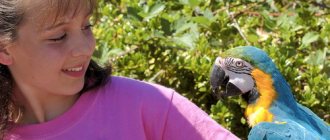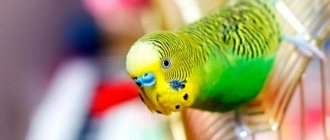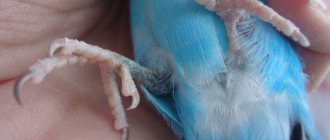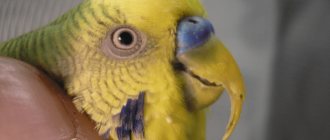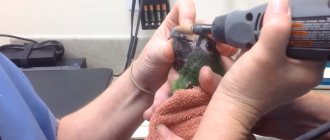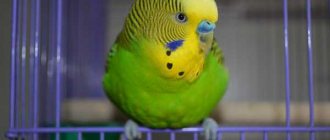Many owners are faced with the fact that their parrot is afraid of hands, toys, new food and other things. Here is a way to solve this problem. In all situations, the approach will be the same - to find the root cause of fear and, depending on the cause, eliminate it or demonstrate to the pet that this object or event is safe for it.
Our feathered friends can indeed be afraid of various things and actions that, in the opinion of a person, not only should not be perceived negatively by the bird, but also bring pleasure to the feathered friend. It is up to the owner of the parrot to understand the nature of the pet’s fear and do everything possible to make the bird feel safe.
Hand Taming
How to tame a budgie? First you need to remember a few simple rules. Accustoming a budgerigar or any other parrot to being handled requires the following:
- Taking into account the age and gender characteristics of birds. A boy learns a little differently than a girl.
- Thoughtful and correct actions.
- Regular classes. If they are carried out irregularly, from time to time, then you may not expect a normal result.
After the bird is no longer afraid of the human voice, you can move on to the next stage of training. You need to open the cage door with smooth movements and stick your hand in, each time getting closer to the bird. At first she will worry and scream, but this is an absolutely normal reaction to danger. You cannot touch or pet the bird yet, otherwise the whole process will have to be repeated all over again.
How to accustom a parrot to your hands
Raising a mature bird is not easy, but it is quite possible. If before this she lived in good conditions, but had almost no contact with people, you need to pay a lot of attention to her and talk to her every day for an hour. If the parrot has experienced stress or been abused, the chances of success are minimal. Such birds are afraid of humans and are even capable of biting. Of course, love and affection can change their attitude, but you will have to show maximum care, do not make sudden movements and under no circumstances shout. All this will scare the pet even more.
Taming
The best option for a beginner in communicating with parrots is to buy a young parrot, which is much easier to make contact with a new person and can more easily tolerate a change of environment. All the stages of rapprochement described above will be easier for a young bird than if you began to tame an adult. So, the best way to get to know a young budgie is to talk, but only from afar. Your pupil will definitely become interested in you and will take a long and careful look at the new object, which also makes sounds. Another way to please this temperamental bird is to identify its favorite treat. But don't spoil her too much.
For example, if your bird is trainable and does what you ask of it, thank it by hand-feeding it its favorite treat. Let the young parrot get used to the fact that he only gets tasty things from your hands. First, push the treat through the bars of the grill, and after a while do this through the open door. Without the rods the level of trust will be much higher and the parrot understands this too. The next step is to offer this delicacy outside the cage, during a walk. For example, when a bird sat on your finger or actively played.
It will be more difficult to find a common language with an adult parrot. But it is more difficult in terms of time, because a mature bird tolerates a change of environment and new living conditions much more difficult. And to gain her trust, you will need a lot of time and patience. But the recommendations for taming remain the same. Not a single parrot has ever refused delicious food, games and walks. Talk to him more often, show attention and play. And then even the most hardened character of the parrot will soften - and you will become friends.
Unusual ways
If you have no idea how to teach a parrot to sit on your hand, try an unconventional teaching method. To do this, it is enough to trim the flight feathers on the wings. The bird will not be able to fly and will be forced to sit on the palm. But after the feathers grow, there is no guarantee that the bird will be tamed.
There is another recommendation that allows you to train a parrot in just a few days. Place both palms into the cage at once and keep them there. When the pet gets tired of fluttering, he will climb into your arms. On the fourth day of such experiments, the bird gets used to its new owner. But this method is not suitable for everyone, as it puts a strong strain on the psyche. The parrot will sit on your hands, but will still be afraid.
What to do if the bird does not make contact?
There are times when all efforts and tricks were in vain. The parrot does not want to sit on your hand or shoulder, and does not understand the simple command: “No.” This happens sometimes. Perhaps the bird is not healthy or is experiencing stress.
How to trim the claws of a Corella parrot at home Find out more >
If both health and emotional state are normal, then apparently this is the case when the bird simply cannot be tamed.
What to do in such cases? If the lovebird is lonely, then it is best to pick up and place a couple in the cage. The company is interesting in life and the two of them will have a good time.
How to tame an adult parrot
It is easier to tame a young parrot, especially if it is a male. An adult requires a longer period of training. It is quite difficult to tame an adult parrot that has not been handled before, even if it is a boy.
Work with birds is carried out according to the same scheme as with young birds:
- gaining trust;
- hand training inside the cage;
- departures from home with landing on hand.
Experts advise increasing the duration of training with an adult bird to 20–25 minutes. The number of lessons per day is at least two. It has been noticed that taming adult female parrots is more difficult. On average, females get used to hands in about a month.
Example of actions for fear of toys
For example, a parrot is afraid of a new toy or any toys in general. What to do in such a situation? First, show him that this item is safe for you, that is, you yourself enthusiastically play with this toy, rejoice and show positive emotions. The winged pet, being very curious by nature, will want to join your fun after a while.
Reward your pet generously for the slightest attempt to come closer to the toy or touch it. Use treats or just strong emotional praise as a reward. Do not force or force your bird to make contact with the toy if it does not want to. She must want to approach the new object herself.
Bird training should be slow and gradual; you should not try to speed up the process. If your pet begins to touch the toy, this does not mean that it is time to hang it in the cage. For him, this is a still unknown thing that poses a danger to him. Speeding up the process can lead to the opposite result and all your efforts and time spent getting to know a new subject will be wasted. Another example, a feathered pet is afraid of water procedures. Proceed in this situation in the same way - put his favorite things, if any, or treats in the parrot’s bathing suit. Encourage any attempt to approach the bathing suit from the bottom of your heart. And over time, bathing can turn into a favorite pastime.
Love, patience and gradual learning pay huge dividends. By gaining the trust of your pet, you can make the life of your feathered pet happy and safe.
Let's look at the most common dangers in our apartments
- Open windows.
If the parrot flew out the window, then proceed as follows. Immediately inspect your surroundings. Place the cage outside, put food and toys in it. If there are other birds, take them outside so that their singing will attract the fugitive. If there are sounds that your pet likes (for example, a song or melody), turn it on outside. Post notices around the area. Walk around the area and look! A pet that has flown away - this tragic situation is especially common in the summer. What is the cause of the problem? First of all, these are open windows. A parrot can fly out of a window, even if it is not a particular fan of flying, so it is recommended to close the windows during its walks, or put special nets on them. Closed windows also pose a danger. Not all feathered pets understand that there is glass between the room and the tree outside. The bird may hit the glass in flight and be seriously injured. To avoid this situation, hang curtains and curtains on the windows. - Water procedures.
Bathing a parrot also carries a certain risk. When taking water procedures, make sure that there are no drafts in the room. A draft is deadly for a wet bird. - Walking on the floor.
Any walking of the bird on the floor is unacceptable. It is better to wean yourself from this from a very early age. Birds can walk very quietly and unnoticed on the floor, and you and your family members will not always be able to control where you step. Many will say that this is a strong restriction, because he so likes to roam around the carpet. Yes, this is of course a limitation, but how many birds could it save the lives of? - Parrot in the kitchen.
Having a parrot in the kitchen poses a threat to its life and health: open fire, household chemicals, deep containers of water, Teflon fumes (more about them below). The kitchen is no place for birds! But if you still allow your pet to be in the kitchen with you, then make sure that there is no fire on the burner (or the electric stove is turned off), the water tap is closed, everything inedible and dangerous for the bird has been removed from the table, all cleaning household chemicals are hidden in the closet... It is almost impossible to provide for and remove everything, so it is better to exclude the parrot’s kitchen as a place with a very high potential danger. - Other pets.
Never leave your feathered friend with another pet unattended, even if they are friends and dote on each other. Rats, hamsters, dogs, cats and parrots are not friends. There is always a tragic accident. And you will have to blame yourself, not the dog or cat. - Plants that are poisonous to parrots.
All of them can be grouped into: deadly ones, then those that cause temporary problems, and those plants whose individual parts are dangerous (root, flower, leaves, fruits). This If you are not sure that your indoor flower is not poisonous to your winged pet, then it is better to move it to a room to which your pet does not have access. - Drafts.
Even if the room is hot, a draft is extremely dangerous and can cause a cold. - Household appliances with Teflon non-stick coating.
Evaporating Teflon vapors when heated are fatally poisonous to parrots. Therefore, carefully choose a hair dryer, iron, room heater, frying pan, etc. Or use them in a room where the bird does not appear. - Guests.
Even if you are the most responsible bird owner in the world and know everything that can be given to a bird from food, this does not mean that your guests know anything at all about birds. Candy offered by a guest can be fatal for a pet. If you cannot control your guests, it is better to limit your feathered pet’s access to them altogether. Never leave the children of your guests with the bird without your supervision. This can be dangerous for both the pet and children (for example, a bite). - Toys.
The condition of all toys purchased at a pet store for parrots or made with your own hands must be monitored. Toys for birds should not be worn out or shabby. Your pet can become entangled in worn out rope toys. Plastic toys must be washed regularly, i.e. Dust or food residues often accumulate on them. - Perfumes, air fresheners.
They contain essential oils that are poisonous to birds; do not use them in a room with a feathered pet.
Let the bird get used to it
Do not forget that for a budgerigar, sitting in a person’s arms is stressful. After purchasing a pet, you need to give it time to get used to its new shelter a little. Making sudden movements or shouting loudly near the cage is not recommended in the first few weeks. You shouldn’t expect that a new family member will become tame in just a couple of days - you need to be patient. Cleaning the cage, changing the water or feeding bowl should be done carefully and smoothly, without sudden movements.
It is best to place a budgerigar's house in a place so that the animal can clearly see its owners and can recognize members of the household. Don't forget to talk to the bird, repeat its name, speak calmly and friendly.
For those who do not know how and when to tame a budgie if it is afraid, you should pay attention to the following fact. If a pet calmly eats its food in the presence of its owner and does not panic, then this is a good sign. The bird should also not react negatively to movements from the side of the cage and calmly go about its business. This behavior indicates that it is time to move on to learning.
Adaptation first
Like other pets, these birds must first get used to their new living conditions after being separated from their parents. This process is lengthy. And from the first days of your parrot’s stay in your apartment, you need to take a closer look at him in order to choose the right name for him.
Despite the fact that parrots are very sociable individuals by nature, they are also very cautious. Therefore, you should not try to get the bird out of the cage in the first days. Let her first get used to it, spend a few nights, take a closer look at the surroundings, try out the perches and swings, that is, get comfortable in her house. Perhaps in the first days the parrot will sit in the corner of the cage, getting used to those around him, studying everything around him. But soon even the most distrustful parrot will get tired of this and make contact. Then you need to call him by name. It is recommended to teach the name so that your eyes are at the level of the bird, and not looking at it from above. This will allow her to feel like an equal with you. Do everything calmly, gradually, without pressure or haste. The main thing is to be patient. Don’t expect that the bird will sit on your hand in just a few days and feel calm. For any bird, being in a person's hand is very stressful. In the first week or two of adaptation to the new home, the parrot will be afraid of any active movements near the cage. By the way, it should be placed so that it is convenient for you to approach it, and the bird can see who is approaching it and when. Do this while pronouncing the parrot's name. When cleaning, changing water and filling the feeder, take your time so as not to scare the bird.
The main sign that your flying pet has already managed to adapt to a new place is a calm meal in the presence of the owner
And when your flying friend stops paying attention to your approach to the cage during a meal, it means that the adaptation has been successfully completed, and you can begin to tame the parrot in your hands
Communication with a parrot outside the cage
Walking around the room and free flights are very important for the health of feathered friends. As a rule, it is not immediately possible to train budgies to get out of their usual house. These birds are very careful.
It is recommended to teach a parrot to leave its home as follows:
- open the door;
- move away 2–3 m and call your pet;
- show the bird a treat in your open palm and call it in a low voice.
The pet's first independent flights from the cage end in quick returns. The bird prefers to eat the obtained delicacy in a familiar environment. You can't blame her for this. Attempts should be repeated.
Soon the budgerigar will no longer be afraid of the room, and will deal with treats right in the palm of the owner. After a few more days, he will begin to fly out of the cage without food stimulation, and he will want to communicate with a person. Calm conversation, no sudden movements and affection will help you build your parrot's trust.
What causes the feeling of fear?
When arriving at a new place of residence, the pichuga experiences stress. Anything can scare her: toys, a cage, the hands of the owner.
Reasons why a parrot may be afraid
Factors causing the feeling of fear:
- Incorrect behavior of the new owner: sudden movements and sounds, attempts to grab the bird, forcing it to play or eat.
- No adaptation period. The pet needs 2-4 weeks to get comfortable in its new home and get used to the owner and household members. While the bird adapts, it does not need to be released from the cage.
- Mental trauma caused by the previous owner or breeder.
- Character traits. Each bird is individual: some individuals are brave and immediately make contact, others are cowardly and sensitive to any irritants.
To help your pet cope with fear, you need to show him that the object that frightened him is not dangerous. Use positive reinforcement: as soon as the bird itself approaches the source of fear, it needs to be rewarded with a treat.
What are budgies afraid of?
Observing the bird will help you find out the source of its fear.
Mostly pets are afraid of:
- hands or voice of the owner;
- new cage and toys;
- water procedures;
- strangers;
- sharp, loud sounds;
- flashes of light or complete darkness;
- other pets;
- new food.
https://youtube.com/watch?v=nMz625g177k
Fear can be instinctive or reinforced by negative experiences. For example, a parrot may be afraid to sit in a person's arms because this behavior is not typical for it, or because the previous owner grabbed it roughly.
Possible problems
When trying to tame a budgie, many owners encounter a number of difficulties that prevent them from doing so. Here are the main ones.
The bird basically does not want to contact humans
The fear of hands is quite justified, because in the wild they are not friendly with humans. To get rid of this problem, they use the method of positive reinforcement, that is, as soon as the pet has done the right thing (sitting on your hand), it receives praise, food or a toy.
Usually this problem is solved over time, because parrots are by nature very sociable creatures and they do not like loneliness. If you show more patience and surround your pet with care, and most importantly, do not make mistakes when training, then success will definitely come. To make your pet feel more interested in you, try the following:
- if the bird is alone in a cage, offer it an “animate” toy that it can take care of;
- Parrots also love to play with ballpoint pens and caps;
- Place a mirror in your feathered home - he will be delighted with such a new thing and will be happy to look at himself in the mirror and talk to himself, which will help him not become isolated.
Refuses to return to cage
This often happens if a parrot flies away from your hand during taming training. He can circle around the room or fly from object to object. This can be dangerous for the bird, for example, if the window is not curtained, and it will fly into the glass in a big way, and will cause inconvenience to the owners
To correct the situation, there is the following way: wait until dusk, it is important to remember where the bird is sitting, and in the dark carefully transfer it to the cage
When he ends up in the house, you don’t have to worry about the further fate of the bird. When the light is turned on, he will calmly accept the fact of moving. In addition, now he will be in your hands, and this will once again show him that the person does not pose a danger.
Bites
When feeding birds, some owners are bitten. It is clear that this was not done out of malice - the parrot simply did not calculate the movements. This also happens when kissing a pet who was not as gentle with the process as the owner. Often such incidents occur with very young birds - this is how they, like children, learn about the world. And when the owner puts his hand into the cage, the parrot can perceive this as a call to play, and simply peck at the finger, like a branch, in order to hold on.
All of the above “bites” occur more by accident than on purpose. But there are times when a parrot bites for protective reasons. This can happen with frightened birds or during the mating season. First of all, you should not shout back - try to restrain your emotions, especially negative ones. You can lightly click a baby’s beak and say “no,” but you can re-educate an adult by leaving the room with an offended look.
A budgie can be a great friend for all family members. Tame it in stages, step by step, treating your bird with care.
More information about the secrets of taming budgerigars is described in the video below.
Why does the wavy bite and become aggressive?
There are several reasons why a parrot bites. Aggressive behavior can manifest itself not only before taming, but also in a bird that calmly walked towards its owner.
Puberty
Usually people do not experience any particular difficulties with taming if they acquire a young individual. To establish contact, it is enough to feed the bird by hand, pamper it with treats, speak in a pleasant and soft voice, and also pay a lot of attention to it, playing with different toys. But at a certain point in time, the pet’s behavior changes dramatically. If a bird suddenly begins to bite and behave aggressively, this may be due to puberty.
Even the kindest and most cheerful parrots at this time become angry, gloomy and unfriendly. They happily bite the hands of the owner, with whom they previously kissed and played. Typically, such aggression goes away after the end of the maturation period, so the bird becomes affectionate and playful.
If at this time the bird notices that it can manipulate a person with the help of bites, then this habit is reinforced, so it will be quite difficult to wean it off.
A surge in hormones can occur for various reasons, including increased daylight hours, increased humidity, or other external factors. Sometimes the process even begins with daily bathing in the summer. Typically, aggressive behavior is characteristic of males, not females.
Games with rustling objects
If a person lets his pet play with rustling paper bags, boxes or sawdust, this stimulates the reproductive instinct. Birds often associate such soft objects with a nest, and the wavy bird chooses a human as its partner, so it will bite him. With these actions, the wavy insists that the hand remain in the cage.
If paper or boxes are left in a cage where a couple of wavy birds live, then fights can even occur between the birds. If they begin to prepare the nest and prepare for mating, then the aggression will be directed at the person who will interfere with the birds. Males under such conditions treat people as rivals, so they bite hands. Usually such bites are really painful and also leave deep wounds.
Audible and visual stimuli
Sometimes birds become excited by various external stimuli, which leads to aggression. They begin to quickly run around the cage, bite, scream and fly from perch to perch.
Typically this reaction occurs to the following stimuli:
- meeting a new bird or pet;
- placing a pair of parrots in different cages, so the birds see and hear each other, but do not have the opportunity to be close to each other;
- rustling of paper, candy wrappers or cellophane;
- extraneous sounds, for example, pouring water, and often such sound becomes the cause of aggressive behavior;
- the squeak of hungry chicks, to which the female or male for various reasons do not have access;
- sounds of birds from the street.
The above irritants can cause aggression, so it is important to monitor your pet’s behavior to determine the main stimulus.
Territory defense
If the bird has constant and free access to the apartment, since the cage is open all the time, then it may have a desire to protect its territory. This usually manifests itself in the fact that the wavy constantly sits on the lid of the cage, and also screams loudly when other birds, pets or humans approach.
Such parrots have a negative attitude even towards cleaning the cage, so they bite their hands a lot. This indicates that the bird is afraid of losing its territory. To change the bird's behavior, you need to place the cage on the floor or on a low shelf so that it is below the person's eyes. It is advisable to close the bird in a cage for several days so that it wants to be free and refuses to defend the territory.
Aggression
Many owners allow the pet to climb onto their shoulder, where the bird spends a lot of time. Ornithologists are confident that such a solution leads to bad results. Wavy becomes confident in himself, and also considers the person not as a master, but as a rival. Therefore, he can bite the hand, ear or other part of the body at any time.
In practice, there have been cases when tamed wavy animals suddenly showed aggression , leaving scars on the face or even damaging the integrity of the eyeball. It is quite difficult to remove a bird from your shoulder without screaming and biting. Therefore, it is advisable to hold the wavy on your hand during games and communication, without bringing it to eye level.
Active entertainment
The reaction of parrots to active pastime can be compared with the consequences of children's active games. At first, the wavy bird enjoys attention, play and communication, but after a while the bird becomes uncontrollable. She begins to pinch and bite, and does not realize that she is hurting.
If such games are played with an adult parrot, then they act as a competition, thanks to which the pet determines the leader, and it is he who strives to achieve the most important positions. If the owner condones this behavior and also allows the parrot to bite household members, then aggression will only develop.
The silence of a person signals that the wavy is really the head of the family, and therefore will bite all family members without good reason. Therefore, at the first signs of aggression during play, it is advisable to stop all entertainment, put the bird in a cage, and also say the word “No” in a stern voice. Such actions will allow you to control the dispersed parrot.
Fear or stress
Bites are often a way of defense during stressful situations. If a bird is afraid of a person who does not use effective taming methods, it will bite hands and other parts of the body.
Under such conditions, it is necessary to take the advice of ornithologists to quickly get closer to the parrot. This will reduce stress, establish friendly and trusting relationships, and the wavy will begin to feel calm and free in the apartment or house.
Jealousy
Although wavy birds are curious and sociable birds, they can be jealous of their beloved owner of other birds, pets or even people. Sometimes people note that their pet is jealous of inanimate things. Often wavy animals have a negative attitude towards the other halves of their beloved owner. They are afraid that a person's love and attention will spread to another, so they begin to bite to attract attention.
Jealousy is especially evident when a person is talking on the phone without paying attention to his pet, so at this time the bird begins to bite heavily, scream and fly around the owner.
Violation of the regime
It can be presented in several varieties:
- Feeding at night or at different times. Parrots feel negative if they receive food too late or without any schedule. For them, food is an important part of life, so they suffer in its absence. If the owner cannot give food to the pet in a timely manner, this leads to aggression and bites.
- Nap. Birds need to sleep for quite a long time, at least 8 hours. Some individuals even need 10 hours of sleep. If the wavy does not get enough sleep, then it becomes nervous, irritable and aggressive. Often this condition becomes the cause of early puberty. To prevent such negative consequences, it is recommended to cover the cage with thick fabric at night and not turn on the light at night.
- Waking up early. If the bird wakes up too early, it may bite because it feels tired. Therefore, it is recommended to wait a little, after which you can release the bird from the cage and begin communication.
- Long absence of the owner. If a loved one goes on vacation or a business trip, the bird becomes irritated, nervous and worried. After returning, the wavy begins to rejoice and get excited, which often leads to aggressive behavior.
To avoid such negative consequences, it is recommended to establish the correct sleep and rest schedule in advance.
Problems with taming
If you buy not a young chick, but an already adult wavy bird, then difficulties with taming often arise. They cause the bird to behave aggressively.
These include:
- the bird is not aware of important norms and does not respect the boundaries set by the owner, and it is almost impossible to wean a five-year-old bird from biting;
- fast pace of taming, so it is advisable to choose a slower and calmer pace that does not cause negativity in the pet;
- learning words, which often leads to agitation, so you need to stick to the learning plan;
- lack of freedom, so if a bird spends too much time in a cage, then it will be unhappy with the person;
- loneliness, so if the wavy cannot communicate with relatives or people throughout the day, then it becomes irritable and wild, which leads to severe bites.
Therefore, it is necessary to pay as much attention as possible to training your parrot.
The parrot loves to bite
Some wavy fish are experienced manipulators, so they achieve their goals with the help of bites. They force the owner to do the things they need. If they don’t like a person’s behavior, they bite, scream loudly and flap their wings.
You cannot indulge such behavior, since it is almost impossible to wean a bird from biting if it is spoiled and arrogant.
